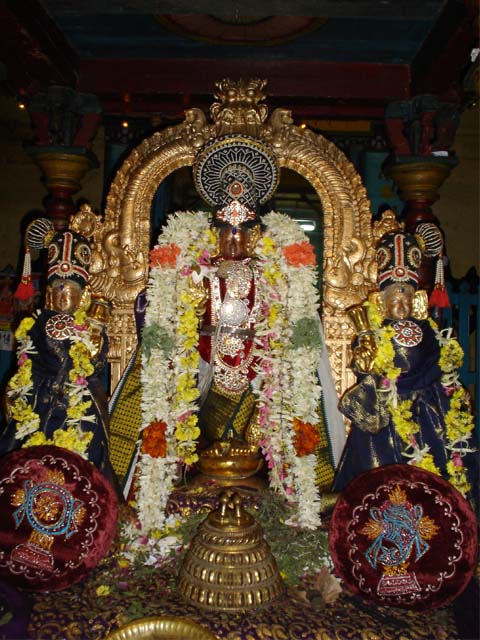
The Lord displays the Red color of pavalam [பவளம், प्रवळ, coral]. Sage Brgu, Aswini Devas and other sages meditated here. They prayed to see the Lord on pavala vannam [coral color] and accordingly, the Lord is gracing here. Great poet Pillai Perumal Iyengar [பிள்ளை பெருமாள் ஐயங்கார்], composed ashta prabhandam. He composed one pasuram for each of the 108 Divya desams. He says the Lord appeared in White color like butter; black color like rain bearing clouds; green and Yellow mixed color; and, red like coral. Moolavar is in seated pose. Adisesha is acting like umbrella. He is showing abhaya to the devotees. If we carefully observe we can see the hue of coral, on the Lord, Utsavar, Who has right hand in abhaya mudra and left arm holding the mace.

We can see the belt [ஒட்டியாணம் in Tamil ] in the waist. The Lord is wearing many ornaments and garlands. Sri Thayar is Sri Pavalavalli, is seated and one arm shows abhaya and the left arm is in varada mudra. We will now see sloka 24:
nabhah-sprsam diptam aneka-varnam
vyattananam dipta-visala-netram
drishtva hi tvam pravyathitantar-atma
dhrtim na vindami samam ca visno
"O all-pervading Vishnu, seeing You with Your many radiant colors touching the sky, Your gaping mouths, and Your great glowing eyes, my mind is perturbed by fear. I can no longer maintain my steadiness or equilibrium of mind."
Arjuna addresses the Lord as Vishno. Vishnu means pervading everywhere [व्याप्ति vyapti ]. The Viswaroopam is spread everywhere and so Arjuna addresses as Vishno! Nabah-sprsam = [the Lord's] head is touching Paramapadam or Vaikuntam, diptam = illuminating, aneka varnam = many colors, vyatta = wide opened, ananam = mouth, dipta = bright, visala = large, netram = eyes, tvam = [such described] You [Sri Krishna], drishtva = having seen, pravyathita = frightened or trembling, antar-atma = conscience or mind, dhritam na vindami= [Arjuna] can not support [his body], samam = [Arjuna's mind] equilibrium. By seeing the gigantic image of the Lord with head touching the farthest Vaikuntam, many colors being displayed by the body, wide opened mouth and large eyes, Arjuna is frightened and so is unable to control the shivering body losing stability and mind is perplexed losing balance. In sloka 23 Arjuna told that he was also afraid like others, who saw the Viswaroopam. This sloka explains the fear he had. Nabha means sky and sparsm is touching. So it should mean the Lord's body was touching the sky. But the great commentators interpreted this to mean the Lord's image was touching the Paramapadam or Vaikuntam. Because earlier [sloka 11.20] Arjuna exclaimed that the Lord's image went beyond sky and all the intermediate worlds. Beyond sky is Satya loka of lord Brahma, then the Moola prakruti, then Viraja river and finally Vaikuntam. Also, since Arjuna addresses as Vishnu, it should mean that the Head of the image was touching Vishnu loka or Vaikuntam. Upanishads say tad vishnor paramam padam sada pasyanti sooraya: [in that supreme place of Vishnu, Nityasuris are constantly viewing the Lord - even without winking]. The sky we see is visible to the ordinary eyes and Arjuna with the gifted Divine eyes was able to see the Lord's image stretching as far as Vaikuntam. But does it mean that Arjuna was able to see Vaikuntam? Vaikuntam is not visible to Devas, not even to lord Brahma in Satya loka. So what is meant is that Arjuna saw an image very huge and he did not know upto what level it was stretching. He said earlier that Devas and Gandarvas were all seeing the image in fear. So, we have to deduce that he meant the image stretched to Vaikuntam and not the sky we see with our ordinary eyes. Or, the Lord earlier said that He is pervading Vaikuntam and the lower Worlds, without exception. He also said that all these were a small part of His body. Arjuna is relating the words of the Lord told earlier and the present sight of the image stretched gigantically. Therefore, he could be refering to Vaikuntam. He sees many colors radiating from Viswaroopam. Alwar says that when Hiranyakasipu was killed, the red color of the blood, the reddish sky as it was evening, the Lord's face in red color as He was angry and the red color of the tongue of the Lord - all these provided a concentrated red color! Like this many colors are seen by Arjuna. Arjuna sees the wide open mouth of the Lord. After all, the Lord swallows everything in the Universe during pralayam or samharam. On another side He is also spitting out everything during creation or srushti. The eyes are very large - to search for evil minded persons like Ravana and Hiranyakasipu, and to grace coolly devotees like Prahalada and Vibheeshana. Since Arjuna had never seen an image like this, he is frightened and trembles. His body is shaking and so is not stable. Though Viswaroopam might be frightening, the images of the Lord in various Kshetrams are pleasing to the eyes.
No comments:
Post a Comment